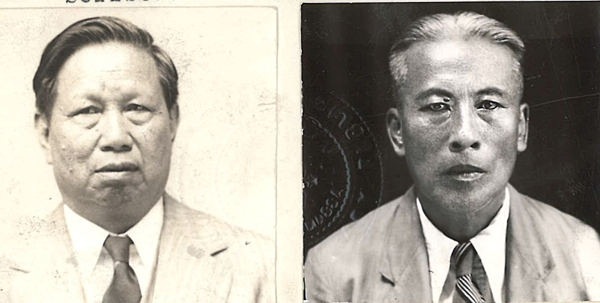
This file contains documents and photos of Lee Quong On from 1901 to 1941. Lee was born in San Francisco on or about 20 June 1879. He and his parents returned to his parents’ village in China when Lee was about seven years old. In 1898 Lee married Wong She in Chu Ging village, Sun Ning district. They had one child, a son, Lee Or Yuen, born in 1900.
In early 1901 Lee Quong On left China. He arrived in Vancouver, British Columbia, Canada; then took a train to Montreal, Quebec and made his way to Burke, Franklin County, New York. He was immediately arrested. On 15 March 1901, he was brought before Hon. William V. S. Woodward, U.S. Commissioner of Plattsburgh, N. Y. and charged with unlawfully being in the U.S. A trial was held. He and three witness: Chin Sing, Chin Dan and Tsao Dong, testified in his favor. The evidence was considered, the charges were cleared, and Lee was released. He received his discharge certificate with his photograph attached in August 1901 at Port Henry, New York from Fred W. Dudley, a United States Commissioner, Northern District of New York.
When Lee Quong On applied to go to China in 1908, he swore in an affidavit that he was born in the United States to Chinese parents, went to China with his parents at a young age, and returned in 1901. He told how he was arrested at Rouse’s Point, New York in 1901 and taken to jail at Plattsburgh, New York but eventually was released and given his discharge certificate. His 1908 departure was approved, and a current photograph of him was attached to his affidavit. He left for China through the Port of Richford, Vermont.
Lee returned through Vancouver, British Columbia in August 1911. He was 32 years old, marriage name of Lee Doon Po, a laundryman, and living in Boston, Massachusetts. Lee exchanged is discharge certificate for a certificate of identity.

Lee’s next visit to China was in 1916. By this time, he was a merchant but still living in Boston. Charles V. Slane was a witness for him. Lee was issued United States passport #2220 before he left the U.S.

In 1940, Lee wanted to return to the United States. He was a merchant at the Ow Sang Market but because of the war with Japan, the market was being disturbed by the Japanese bombers. He felt it was dangerous to stay there. His Boston attorney, John G. Sullivan, wrote to the Director of Immigration in Seattle to make sure Lee’s papers were in order. Lee’s passport had expired many years ago. Chin Hong Ark, also known as Chin Ming, swore in an affidavit, that Lee Quong On, aged 60 years, was a U.S. citizen. Photos of Chin Hong Ark and Lee Quong On were attached to his affidavit. When Lee left for China in 1916 he left his discharge papers and his certificate of identity at the Seattle Immigration office. They were both in his file.
Lee Quong On was admitted to the United States at Seattle on 3 February 1941.








